Canon AE-1 Film: Understanding Choices and Development Options for Photographers
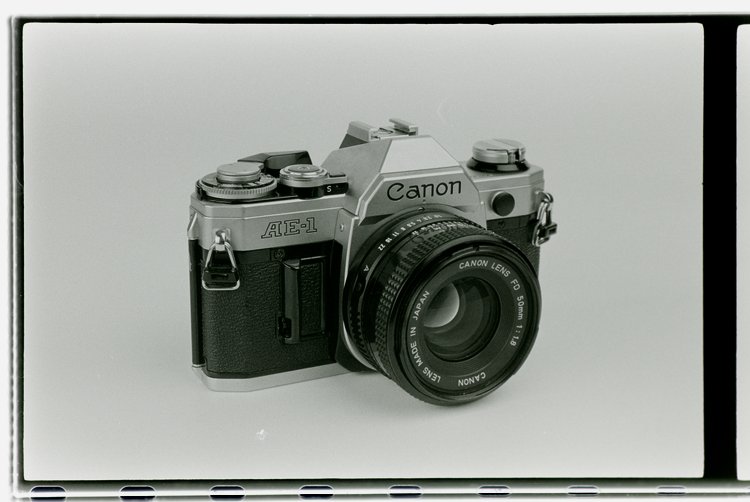
The best film to use in your Canon AE-1 will depend on your lens, lighting conditions, and if you want to use color or black & white.
To avoid having to haul around a tripod or flash, pick a film that has an ISO of 400 or faster.
Make sure that you have a fast lens if you want to capture images in low light, conditions that are frequently encountered indoors. See my blog post on the 5 Best Lenses for the Canon AE-1 for recommendations. (These also apply to the Canon AE-1 Program)
What Film Does the Canon AE-1 Use?
The Canon AE-1 uses 35mm film, often referred to as 135 film, which is the most common form of film used in photographic cameras.
- Format: 35mm or 135 film
- Frame size: 24mm x 36mm
These films are available in both color and black-and-white variants. Combined with a few Canon FD interchangeable lenses for the AE-1, and you have access to a wide wide range of creative possibilities.
Understanding Film Speed
Film speed, quantified using the ISO scale (also ASA), refers to the sensitivity of the film to light. A higher ISO number means the film is more sensitive and can capture images in lower light, but it also results in a grainier image. Conversely, lower ISO films are less sensitive and provide finer detail, but they require more light to capture a good image.
In practice this means that you will be able to use a faster shutter speed by using a faster film.
For example:
- ISO 100: Good for bright, sunny outdoor situations. Offers fine grain and high detail.
- ISO 400: A versatile film speed that works well in many lighting conditions.
- ISO 800 or higher: Better for low-light situations but produces more grain.
Loading Film into the Canon AE-1
It is important to be carefull when loading a roll of film into the Canon AE-1. You want to do this away for direct sunlight or other powerful light sources. Strong enough light can “fog” or partially expose film that is still in the cannister.
There are guides on how to load film into the Canon AE-1 and how to unload film from the Canon AE-1.
Color Film
Affiliate Advertising Disclosure
Outside the Shot is a participant in the Amazon Services LLC Associates Program, an affiliate advertising program designed to provide a means for sites to earn advertising fees by advertising and linking to Amazon.com.
As an eBay Partner, I may be compensated if you make a purchase. I also participate in affiliate advertising programs with KEH and Adorama. More can be found on the Affiliate Discolsure page.
- Produces colored images.
- Usually offers a wide dynamic range for capturing the subtleties of different hues.
- Requires more precision in exposure setting.
- Development process is more complex, often requiring professional development labs.
Consumer
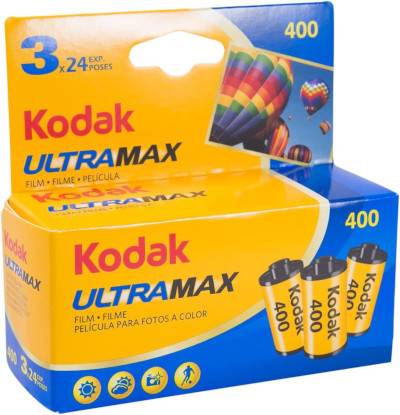
Kodak UltraMax 400 - A good option for an array of conditions. Using this film you should have the ability to handhold the AE-1 in the vast majority of situations.
The photos will have very good colors and leans towards the warm side.
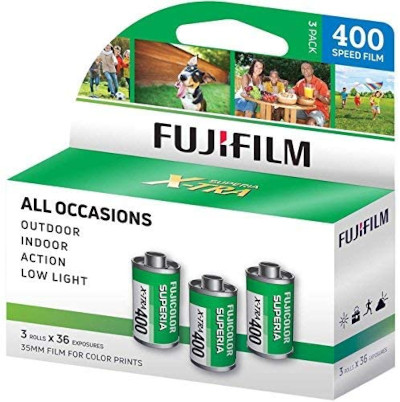
Fujifilm Superia X-TRA ISO 400 - Based on your location, this film can be more widely available. It’s an excellent alternative to Kodak emulsions.
Fujifilm pictures tend to have cooler colors with stronger greens and blues, when compared to Kodak.
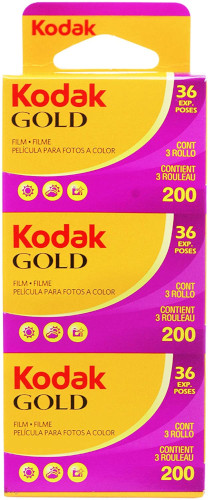
Kodak Gold 200 - A great solution to get that mid-1980s through 90s feeling. For the classic experience use a flash.
Over-expose it by 1 or 2-stops to reveal the best look the film has to offer. This will provide you with the gorgeous colors everyone loves Kodak Gold 200 for.
Professional
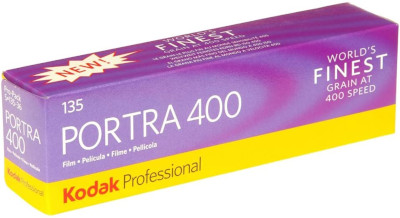
Kodak Portra 400 - By far the most popular color negative film among photography enthusiasts online. Overexpose it by 1 or 2-stops to get the look and feel the film is well known for.
Portra is also for sale in ISO 800 and 160 versions. 8x10 sheets, 4x5 sheets, and rolls of 120 film are also available to buy.
Black and White Film
- Produces images in shades of gray.
- Generally offers higher contrast and better details in shadows and highlights.
- Typically easier and cheaper to develop at home.
- Often has a higher tolerance for exposure errors.
Consumer
With affordable prices and excellent quality, black & white film is very popular for use in the Canon AE-1.
The largest draw for photography students and budget minded photographers is the affordable cost. Even if you would not put yourself in those groups, it is great to have low-priced rolls of 35 film readily available for trying out newly acquired used gear.
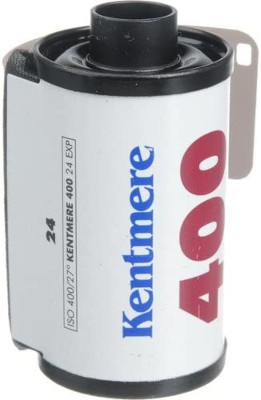
Kentmere 400 - It’s manufactured by the parent company of Ilford, Harmon Technology. This is great since that allows this to be the most broadly sold B&W film out of the 3.
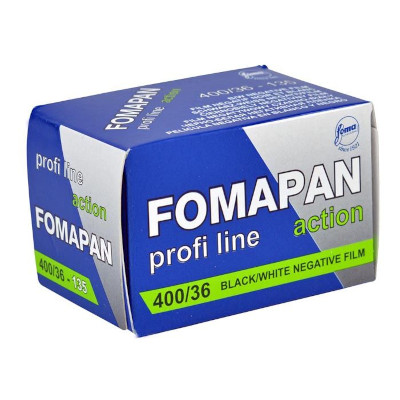
Foma Fomapan 400 Action - It’s much easier to purchase in Europe as the film is manufactured by Foma Bohemia in the Czech Republic.
A great film to try for your initial few attempts at analog photography or home developing. Also a good option if you’re looking to check out a camera to confirm that it is fully operational.
Professional
The 2 most frequently used black and white 35mm film emulsions are Kodak Tri-X 400 and Ilford HP-5+ 400. They have many attributes that are similar that make them popular, while maintaining individual appearances.
You can still get excellent photos after pushing both film emulsions 2-stops. A roll can be used at ISO 400, 800, or 1600, making them remarkably useful.
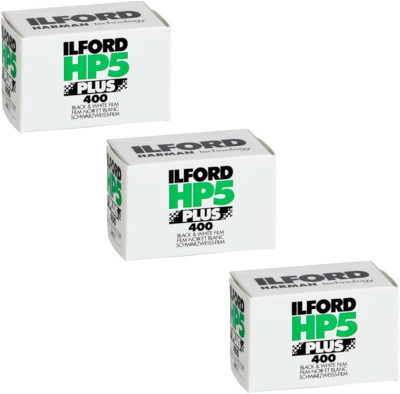
Ilford HP5 Plus 400 - Between the two film stocks, HP5 Plus is less expensive and has lower levels of contrast. Low amounts of contrast can be good because contrast can be added when making a darkroom print or during digital processing.
The film stock still looks outstanding when pushed 2-stops. It is also recognized for having subdued grain.
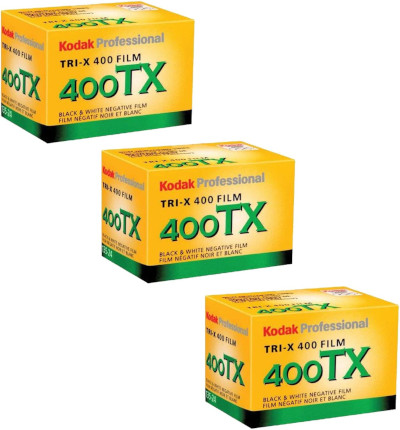
Kodak Tri-X 400 - This film emulsion has got a more distinctive style. To create the old-school grain structure, contrast, and look of the film, it will need to be processed in Kodak D-76.
You will clearly notice more contrast with Tri-X 400. That is great if it is the style you will want because it means a great deal less work when editing digitially or making a print in the darkroom.
Reversal Film
Film emulsions that create a positive image can be called transparency, slide, or reversal film. That means a projector or lightbox can be used to show the slides.
The colors don’t need to be inverted to be viewable, contrary to the more often used negative films.
Slide films have much less dynamic range and latitude when compared with negative films and so they are thought of challenging to use.
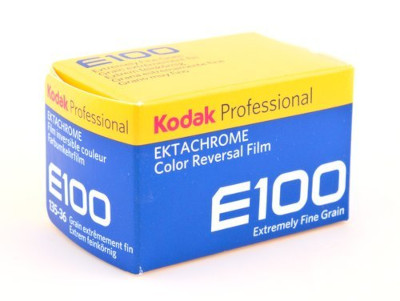
Kodak Ektachrome 100 - This is a fine grain film known for beautiful skin tones. The colors will not look oversaturated. It has a daylight color balance.
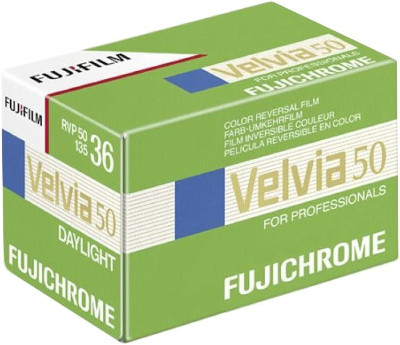
Fujifilm Velvia 50 - Provides appealing looking images that have high levels of saturation and contrast. It is sharp with a daylight color balance. It has the greatest resolving power of any increased increased.
An ISO 100 speed is also available.
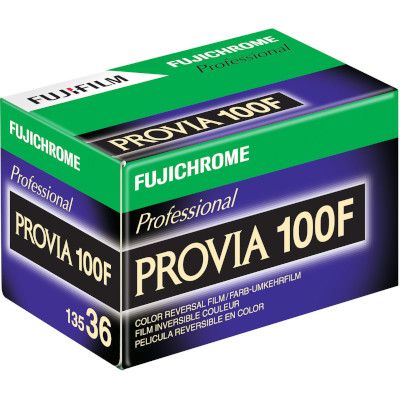
Fujichrome Provia 100F - Produces natural and vibrant colors with moderate color saturation and contrast. It has ultrafine grain with a daylight color balance.
Detailed Information About 35mm Film
Consumer vs Professional Film
Pro film stock have a greater dynamic range, are easier to push, and larger latitude. Previously, this meant that you would expect to pay more for a professional roll of film, but that’s not always the case today.
There may be a difference in where film can be purchased. Consumer film emulsions can often still be purchased from big-box stores and pharmacies in limited amounts. Professional quality film has to be bought from a online or specialized photography store.
ISO
The ISO serves as an indicator of the film’s speed, which is a measure of its sensitivity to light. “200-speed film” or “400-speed film” refers to the film’s ISO value and its corresponding light sensitivity.
The need for higher ISO becomes evident when there’s insufficient light to expose an image properly. However, with higher ISO comes larger film grain, an important aspect to consider.
Lower speed films such as ISO 100 and even slower (like ISO 25, ISO 50) can pose challenges when used handheld with the AE-1. Their slower speed might require more exposure time than you can manage handholding without causing motion blur, unless you are shooting in broad daylight.
In order to circumvent this, you may have to rely on additional equipment like a tripod, a fast lens, or a flash. However, opting for faster films like ISO 400 or ISO 800 may eliminate the need for such gear.
One noteworthy detail for users of the Canon AE-1 is that the ISO dial is labeled as ASA, an abbreviation for the American Standards Association. This nomenclature predates the advent of the International Standards Organization (ISO), after which film speed came to be represented by ISO.
Latitude
Film latitude is the range of stops a film can be overexposed while still maintaining acceptable images. Professional film stocks have a larger latitude paired with a somewhat increased price.
Negative film has more latitude compared to transparency film. That is one of the reasons why it is perceived as difficult to use.
Dynamic Range
The difference between the highlights and shadows details of a photograph is known as dynamic range. Areas of an image that don’t fit within this range will be rendered as black underexposed shadows or solid white overexposed highlights.
When shooting in a wide variety or quickly shifting lighting situations, films with a larger dynamic range is preferable.
- Digital cameras 14+ stops
- Negative film up to 13 stops
- Slide film 6-8 stops
Slide film is viewed as a challenge to use on account of the constrained dynamic range. Golden hour is the ideal time to use slide.
Film Type
35mm film that is sold in metal canisters is used by the Canon AE-1. In addition, it’s the best-selling type of film and sometimes referred to as 135 film.
120 or 220 film, used by medium format cameras, is the only other film format you are likely to encounter}.
Changing the film emulsion you are using will transform the look of your images. This is an example of the excellent things about shooting film.
DX Coded Film
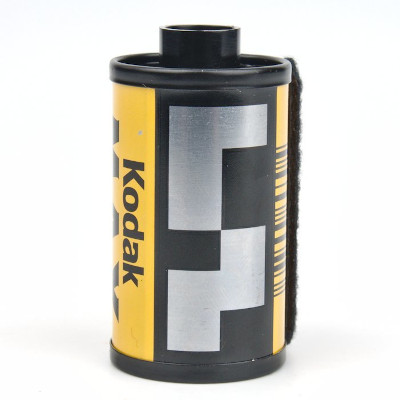
All new 35mm film manufactured today has a DX code. This makes it possible for electronically controlled cameras to automatically detect and set the ISO of the film put in the camera.
ISO (ASA) on the Canon AE-1 must be manually dialed in. So DX-coding doesn’t matter.
Where to Develop Film: Using a Lab or Developing at Home
Depending on your resources and the amount of time you’re willing to spend, you have two primary options for developing film:
-
Professional Lab: This is a convenient choice for beginners and those without much time. Labs are equipped with the right chemicals and machinery to ensure a professional outcome. They often offer additional services like scanning, printing, and retouching.
-
Home Developing: This is a more hands-on process and can be time-consuming. However, it can be cost-effective in the long run and is especially satisfying for DIY enthusiasts. Black and white film is typically the easiest to develop at home due to its simpler process.
Whether you choose to develop at home or in a lab, the Canon AE-1’s classic design and ease of use make it a joy to shoot with. As a photographer, understanding film choice and development is key to mastering this legendary camera and producing exceptional images.
Home Developing and Scanning
You can easily process and digitize any film yourself. In fact it is an excellent method to lower your costs so you can use more film with your Canon AE-1. If you do digital photography and have a macro lens, you can scan film yourself for free.
Black & white film is much easier to develop. Temperature and development times are not as imperative to do correctly with black and white film as time and temperatures are for transparency or color negative.